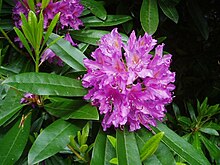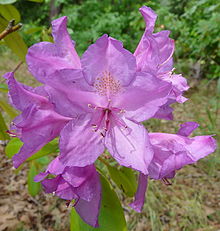Rhododendron ponticum: Difference between revisions
img |
→Description: wikilink botanical technical term |
||
| Line 19: | Line 19: | ||
==Description== |
==Description== |
||
''R. ponticum'' is a dense, suckering [[shrub]] or small [[tree]] growing to {{convert|5|m|ft|abbr=on}} tall, rarely {{convert|8|m|ft|abbr=on}}. The [[leaf|leaves]] are [[evergreen]], {{convert|6|to|18|cm|in|abbr=on}} long and {{convert|2|to|5|cm|in|abbr=on}} wide. The [[flower]]s are {{convert|3.5|to|5|cm|in|abbr=on}} in diameter, violet-purple, often with small greenish-yellow spots or streaks. The [[fruit]] is a dry [[capsule (fruit)|capsule]] {{convert|1.5|to|2.5|cm|in|abbr=on}} long, containing numerous small [[seed]]s. |
''R. ponticum'' is a dense, [[sucker (botany)|suckering]] [[shrub]] or small [[tree]] growing to {{convert|5|m|ft|abbr=on}} tall, rarely {{convert|8|m|ft|abbr=on}}. The [[leaf|leaves]] are [[evergreen]], {{convert|6|to|18|cm|in|abbr=on}} long and {{convert|2|to|5|cm|in|abbr=on}} wide. The [[flower]]s are {{convert|3.5|to|5|cm|in|abbr=on}} in diameter, violet-purple, often with small greenish-yellow spots or streaks. The [[fruit]] is a dry [[capsule (fruit)|capsule]] {{convert|1.5|to|2.5|cm|in|abbr=on}} long, containing numerous small [[seed]]s. |
||
The two [[subspecies]] are: |
The two [[subspecies]] are: |
||
Revision as of 11:47, 20 June 2014
| Rhododendron ponticum | |
|---|---|

| |
| Scientific classification | |
| Kingdom: | |
| (unranked): | |
| (unranked): | |
| (unranked): | |
| Order: | |
| Family: | |
| Genus: | |
| Subgenus: | |
| Species: | R. ponticum
|
| Binomial name | |
| Rhododendron ponticum | |

Rhododendron ponticum, called common rhododendron or pontic rhododendron, is a species of Rhododendron native to southern Europe and southwest Asia.
Description
R. ponticum is a dense, suckering shrub or small tree growing to 5 m (16 ft) tall, rarely 8 m (26 ft). The leaves are evergreen, 6 to 18 cm (2.4 to 7.1 in) long and 2 to 5 cm (0.79 to 1.97 in) wide. The flowers are 3.5 to 5 cm (1.4 to 2.0 in) in diameter, violet-purple, often with small greenish-yellow spots or streaks. The fruit is a dry capsule 1.5 to 2.5 cm (0.59 to 0.98 in) long, containing numerous small seeds.
The two subspecies are:
- R. p. ponticum, found from Bulgaria east to Georgia
- R. p. baeticum (Boiss. & Reut.) Hand.-Mazz. found in Spain and Portugal
Distribution and habitat
In Europe, its range includes Spain, northern Portugal, Great Britain, Ireland and southeast Bulgaria, which is the last surviving European Tertiary habitat.
In Asia it occurs in Turkey, Lebanon, Georgia, the Krasnodar area of southern Russia, the Himalayas, Afghanistan, Tajikistan, Northern Pakistan, and parts of Jammu and Kashmir into the northern Republic of India (Himachal Pradesh, Uttarakhand). It is the state flower of Jammu and Kashmir.
Though it had been present in Great Britain before the last Ice Age, it did not recolonise afterwards and the ecology of the island grew up without it. Its presence today is due to humans introducing it, and it easily naturalises and becomes a pest in some situations, often covering whole hillsides (especially in Snowdonia and the western British Isles). In the British Isles, it colonises moorlands, uplands, shady woodlands (alongside escaped laurels and the native holly) and in areas of acid soils, often in shaded areas.
Historical range
Fossil evidence shows it had a much wider range across most of southern and western Europe before the Late Glacial Maximum, or until about 20,000 years ago.
It was noted by the botanist Joseph Pitton de Tournefort during his travels in the Near East in 1700–02, and so received its name from Linnaeus to identify the ancient kingdom on the south shores of the Black Sea, Pontus, in which it grew. At the other end of its range, in southern Spain, Linnaeus' friend and correspondent Clas Alströmer found it growing with oleander. It was introduced to Britain as an ornamental shrub in 1763, where it is now considered by some to be an invasive species.[1]
Cultivation and uses

Rhododendron ponticum subsp. baeticum is one of the most extensively cultivated rhododendrons in western Europe. It is used as an ornamental plant in its own right, and more frequently as a rootstock onto which other more attractive rhododendrons are grafted. The plants were first grown in Britain in the 1760s, supplied by Conrad Loddiges, and became widely distributed through the commercial nursery trade in the late 18th and early 19th centuries. The roots readily send up suckers from below the graft, often allowing it to overtake the intended grafted rhododendron.
Honey produced with pollen from the flowers of this plant can be quite poisonous, causing severe hypotension and bradycardia in humans if consumed in sufficient quantities, due to toxic diterpenes (grayanotoxins).[2]
Invasive species
Suckering of the root, together with its abundant seed production, has led to it becoming an invasive species over much of western Europe and in parts of New Zealand. Rhododendron control is a key element in nature conservation in those areas.[3] Conservation organisations in Britain now believe R. ponticum has become "a severe problem" in the native Atlantic oakwoods of the west highlands of Scotland and in Wales, and on heathlands in southern England, crowding out the native flora.[4] Clearance strategies have been developed, including the flailing and cutting down of plants with follow-up herbicide spraying. Injection of herbicide into individual plants has been found to be more precise and effective.[5]
References
- ^ Alice M. Coats, Garden Shrubs and Their Histories (1964) 1992, s.v. "Rhododendron".
- ^ Hayes, Andrew Wallace (2007). Principles and methods of toxicology. CRC Press. p. 998. ISBN 978-0-8493-3778-9.
- ^ "New flora and fauna for old". The Economist. 2000-12-21. Retrieved 2008-12-14. [dead link]
- ^ "Rhododendron: A killer of the Countryside". Offwell Woodland & Wildlife Trust. 2004. Retrieved 30 May 2010.
{{cite web}}: Cite has empty unknown parameter:|coauthors=(help) - ^ "BREAKTHROUGH IN BATTLE AGAINST PROBLEM PONTICUM". Forestry Commission. 30 July 2004. Retrieved 30 May 2010.
{{cite web}}: Cite has empty unknown parameter:|coauthors=(help)
External links
- Flora Europaea: Rhododendron ponticum
- Rhododendron Ponticum is the emblem and symbol of Bulgaria's most exotic National Park – The Strandja mountains
- Germplasm Resources Information Network: Rhododendron ponticum
- Centre for Conservation Strategy: Rhododendron ponticum in Britain
- Milne, R. I., & Abbott, R. J. (2000). Origin and evolution of invasive naturalized material of Rhododendron ponticum L. in the British Isles. Molecular Ecology 9: 541–556 Abstract.
